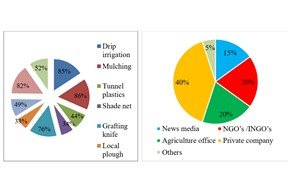Assessment of vegetable production by adopting climate SMART agriculture technologies in Chormara, Nawalparasi district, Nepal
Abstract
Vegetable production is an economic booster contributing around 9.71% to total Agricultural Gross Domestic Production. So, the research study was performed under the topic “Assessment of vegetable production adopting climate-smart agriculture technologies in Chormara, Nawalparasi district” from March- April 2021 to assess the production of selected vegetables i.e. Cucumber, Tomato, Bitter Gourd, Sponge Gourd, and Chilly adopting climate-smart agriculture technology among 100 households applying simple random sampling. The study revealed that 96% of the total respondents were being affected directly by the ongoing climate change and to tackle such scenario 88% of the total respondents were adopting climate SMART Agricultural technologies including mulching, drip irrigation, cultivation of vegetables under the semi-protected house, quality seeds, etc. to mitigate the negative impacts of climate change with increased crop production. To enhance the productivity of vegetables and meet the food security of the increasing global population, farmers were integrating organic and synthetic fertilizers to attain the sustainability of soil health. It was found that 76% of the surveyed farmers were going through market hindrances like lack of proper market, fluctuation in price structure, and poor marketing channel suggesting an immediate need for a proper marketing system in the study area. The highest net return of USD 17588.53 per hectare and B:C ratio of 5.88 in tomatoes illustrated economic viability in vegetable production. Although vegetable production and marketing in Chormara seem a profitable business, the study suggests an immediate need for adoption and scaling up of successful CSA practices, its extension and proper implementation along with the provision of effective marketing channel and setting of minimum prices for the vegetable products based on the cost of cultivation that may overcome the farmer’s problems.
Keywords:
B:C ratio, Booster, Hindrances, Integrate, Market, MitigateDownloads
References
Agrawal, N. K., Bhatta, L., Gjerdi, H. L., & Joshi, K. D. (2018). Creating foundations for resilient agricultural development in Kavre, Nepal. In C. Batchelor & J. Schnetzer (Eds.), Compendium on climate smart irrigation, pp. 112-115.
Agriculture and Food (2020). The World bank. Available from: https://www.worldbank.org/en/topic/agriculture/overview
Ayyogari, K., Sidhya, P., & Pandit, M. K. (2013). Impact of climate change on vegetable cultivation-A Review. International Journal of Agriculture, Environment & Biotechnology, 7(1), 145, https://doi.org/10.5958/j.2230-732X.7.1.020
Azumah, S.B., Adzawla, W., Osman, A., & Anani, P. Y. (2019). Cost-Benefit Analysis of On-Farm Climate Change Adaptation Strategies in Ghana. Ghana Journal of Geography, 12(1), 29- 46, https://doi.org/10.4314/gjg.v12i1.2
CBS. (2011). Nepal Living Standards Survey 2010/11: Statistical Report Volume II. Central Bureau of Statistics (CBS), Government of Nepal, Kathmandu, Nepal, Microsoft Word - Statistical_Report_Vol 2.
Climate-Smart Agriculture in Nepal, (2017). Available from: CSA_Profile_Nepal.pdf (worldbank.org).
Dhakal, R., Bhandari, S., Joshi, B., Aryal, A., Kattel, R. R., & Dhakal, S.C. (2019). Cost-benefit analysis and resource use efficiency of rice production system in different agriculture landscapes in Chitwan district, Nepal. Archives of Agriculture and Environmental Science, 4,(4), 442-448,
https://doi.org/10.26832/24566632.2019.0404011
Funk, C., Dettinger, M. D., Michaelsen, J. C., Verdin, J. P., Brown, M. E., Barlow, M., & Hoel, A. (2008). Warming of the Indian Ocean threatens eastern & southern African food security but could be mitigated by agricultural development. Proceedings of the National Academy of Sciences, 105 (32), 11081-11086, https://doi.org/10.1073/pnas.0708196105
Gairhe, J.J., & Adhikari, M. (2018). Intervention of climate smart agriculture practices in farmers field to increase production & productivity of winter maize in terai region of Nepal. Journal of the Institute of Agriculture and Animal Science, 35(1), 59-66, https://doi.org/10.3126/jiaas.v35i1.22514
Hayes, A. (2019). Understanding the Gross Rate of Return. Investopedia, https://www.investopedia.com/terms/g/gross-rate-of-return.asp
ICIMOD & CEAPRED. (2015). Climate Smart Villages Building Affordable and Replicable Adaptation Pilots In Mountain Areas. Himalayan Climate Change Adaptation Programme (HICAP). Kathmandu, State NO. 3, Nepal: ICIMOD Publication Unit, https://lib.icimod.org/record/30770.
Jha, A., Malla, R., Sharma, M., Panthi, J., Lakhankar, T., Krakauer, N., Pradhanang, S., Dahal, P., & Shrestha, M. (2016). Impact of Irrigation Method on Water Use Efficiency and Productivity of Fodder Crops in Nepal. Climate, 4(1), 1-15, https://doi.org/10.3390/cli4010004
Karki, R., & Gurung, A. (2012). An Overview of Climate Change and Its Impact on Agriculture: A Review from Least Developing Country, Nepal. International Journal of Ecosystem, 2(2), 19-24, https://doi.org/10.5923/j.ije.20120202.03.
Karki, Y. K. (2015). Nepal Portfolio Performance Review (NPPR), Ministry of Agriculture Development (MoAD).
Kifle, T. (2021). Climate-Smart Agricultural (CSA) practices and its implications to food security in Siyadebrina Wayu District, Ethiopia. African Journal of Agricultural Research, 17(1), 92-103, https://doi.org/10.5897/AJAR2020.15100.
Malla, G. (2008). Climate change and its impact on Nepalese agriculture. The Journal of Agriculture and Environment, 9, 62-71, https://doi.org/10.3126/aej.v9i0.2119
Mccarthy, J., Canziani,O.F., Leary, N., Dokken, D. J., & White, K. S. (2001). Climate Change 2001: Impacts, Adaptation, and Vulnerability. Contribution of Working Group II to the Fourth Assessment Report of the Intergovernmental Panel on Climate Change. 19.
Parajuli, S., Poudel, P., & Neupane, H. (2018). Value Chain Analysis of Tomato in Chitwan District of Nepal. Acta Scientific Agriculture, 2(7), 113-116..
Paudel, B. Khanal, R.C., KC, A., Bhatta, K., & Chauhary, P. (2017). Climate-smart agriculture in Nepal. Policy Brief, 1-12.
Poudel, P. (2020). Climate change and its impact on Nepalese Agriculture. Climate Change and Nepal, Climate Change and its impact on Nepalese Agriculture – Climate Change and Nepal .
RECPHEC. (2016). A Report on The Study of Vegetable Markets in context of Kathmandu Metropolitan City.
Rijal, S., & Rijal, B. (2019). Climate Smart Agriculture Concept and Adaptation in Nepal: An Overview. International Journal of Research & Review, 6(1), 47-56, https://www.ijrrjournal.com/IJRR_Vol.6_Issue.1_Jan2019/Abstract_IJRR008.html
Shirsath, P. B., Aggarwal, P. K., Thornton, P. K., & Dunnett, A. (2017): Prioritizing Climate-Smart Agricultural Land Use Options at A Regional Scale. Agricultural Systems, 151, 174-183, https://doi.org/10.1016/j.agsy.2016.09.018.
Sullivan, A., Mumba, A., HAchigonta, S., conolly, M., & Majele, S.L. (2013). Appropriate Climate Smart Techmologies for Smallholder Farmers in Sub-Saharan Africa. FANPRAN Policy Brief, 13(2).
UNDP. (2018). Climate-smart agriculture for resilience in Dolakha. UNDP Nepal, https://www.np.undp.org/content/nepal/en/home/stories/climate-smart-agriculture-for-resilience-in-dolakha.html.

Published
How to Cite
Issue
Section
Copyright (c) 2021 Agriculture and Environmental Science Academy

This work is licensed under a Creative Commons Attribution-NonCommercial 4.0 International License.

